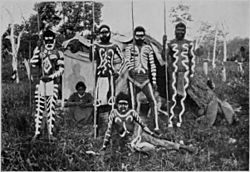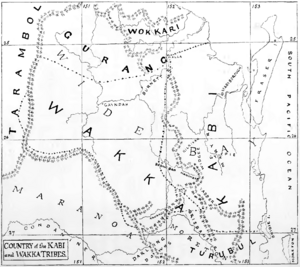Gubbi Gubbi people facts for kids
| Gubbi Gubbi | |
|---|---|
 |
|
| Regions with significant populations | |
| South East Queensland |
The Gubbi Gubbi people, also known as Kabi Kabi, are an Aboriginal Australian group. They come from the south-eastern part of Queensland. Today, they are known as one of the many Murri language groups in Queensland.
Contents
Understanding the Name: Gubbi Gubbi or Kabi Kabi?
The names Gubbi Gubbi and Kabi Kabi come from a word meaning 'no'. This is a common way for different Aboriginal groups to name themselves. The AIATSIS prefers the name Gubbi Gubbi.
There is some discussion about which name is best. Both Gubbi Gubbi and Kabi Kabi are used by different groups of people today.
Gubbi Gubbi Country: Where They Lived
The traditional lands of the Gubbi Gubbi people were mainly around the Mary River Basin. This area stretched north to the Burrum River and south along the coast. It was a large territory, covering about 8,200 square miles (21,238 square kilometers).
Another view suggests their lands were more inland. This area was in the Wide Bay–Burnett region. It covered about 3,700 square miles (9,583 square kilometers). This land reached Childers and Hervey Bay in the north. To the south, it went near the start of the Mary River and Cooroy. Westwards, it reached the Coast Ranges and Kilkivan.
Today, Gubbi Gubbi country is found between Pumicestone Road near Caboolture in the south, up to Childers in the north. Their land was originally thick rainforest. They often cleared areas by carefully burning the scrub.
The Gubbi Gubbi people shared borders with other Aboriginal groups. These included the Turrbal to the south and the Taribelang to the north. The Goreng Goreng were to their northwest, and the Wakka Wakka were to the west.
Gubbi Gubbi Language
You can find information about the Gubbi Gubbi language online. A dictionary of the Gubbi-Gubbi and Butchulla languages was created in 1994. It includes words from both languages with English meanings. It also explains how the words are pronounced and used.
Some people believe the name Gubbi Gubbi comes from the pale honey. This honey was collected from eucalyptus trees in the hinterland.
A Glimpse into History: Contact with Europeans
When European settlers arrived, the Gubbi Gubbi people faced many challenges. There were sad events where many Aboriginal people lost their lives. For example, in 1842, some Gubbi Gubbi people died in a mass poisoning at Kilcoy. More people were killed in 1847 at Whiteside Station.
As settlers moved onto their lands to set up farms, the Gubbi Gubbi and Butchulla people bravely defended their territory. From 1847 to 1853, there were conflicts where settlers and their workers were killed.
In 1849, two young brothers were killed while looking after sheep. In response, a group of settlers attacked a large group of Aboriginal people. Many lives were lost in this event. Later, one of the settlers, Gregory Blaxland, was killed in a payback action. This led to more violence against Aboriginal tribes in the area.
An escaped convict named James Davis lived with the Kabi Kabi people for a time. John Mathew, a clergyman who became an anthropologist, also spent five years with them. He lived at Manumbar and learned their language. In 1910, he wrote a book called Two Representative Tribes of Queensland. He described their society and how their numbers had sadly decreased over time.
Culture and People

The official name for the people is Gubbi Gubbi. You can find more about them on their official website. Many people also use the name Kabi Kabi. Both names are respected and used in land claims today.
Social Organisation: Gubbi Gubbi Clans
The Gubbi Gubbi people were organised into different groups called clans or bora. Each clan had its own name and was linked to a specific area.
| Clan name | Meaning | Location |
|---|---|---|
| Dauwa-bora | Noise of hacking people | North of Mount Bopple |
| Gunda-bora | Cabbage Palm people | Mount Bopple |
| Gigar-bora | Sweet people | Widgee |
| Kaiya-bora | Bite people | near Widgee |
| Kunyam-bora | Pine tree people | South of Mount Bopple |
| Kuli-bora | Native bee people | South Burnett |
| Baiyam-bora | Pipe people | Yabba Creek (Imbil) |
| Butyin-bora | unknown | Musket Flat |
| Wityin-bora | unknown | near Maryborough |
| Wanggur-bora | unknown | unknown |
| Kinayin-bora | unknown | unknown |
| Jakalin-bora | unknown | unknown |
Native Title Claims: Protecting Their Land Rights
Native title is a special legal right. It recognises that Aboriginal and Torres Strait Islander peoples have traditional rights and interests in their land and waters. Different groups of Gubbi Gubbi/Kabi Kabi people have made native title claims. These claims are made through a group called the Southern and Western Queensland Region.
Several claims have been made using the "Kabi Kabi" spelling. Some earlier claims were combined into newer ones. As of 2021, one claim is still active. This claim covers a large area. It stretches from Redcliffe (north of Brisbane) to around Isis Junction in the Bundaberg region. However, it does not include Maryborough. These claims are important for recognising the traditional ownership of the land.
Some Gubbi Gubbi Words
Here are a few words from the Gubbi Gubbi language:
- kavai (a small, stingless, light-grey native bee)
- killa (a small, stingless, dark native bee)
- mothar/dhi (whiteman)
- mular (ceremonial scars)
- (n)a'von (mother)
- pa'bun (father)
- widha karum (wild dog)
- wiyidha/widha (tame dog)
- wunya (greeting)
Notable Gubbi Gubbi People
Many inspiring people come from the Gubbi Gubbi nation:
- Arthur Beetson: A famous Queensland Rugby League player and former Australian captain.
- Tahj Minniecon: A soccer player who played for teams like Brisbane Roar.
- Eve Fesl: A former champion discus thrower. She was the first Koori person to earn a PhD from an Australian university in 1990. She is from both the Gubbi Gubbi and Gungulu nations.
- Lance McCallum: A Member of the Legislative Assembly of Queensland. He spoke about his heritage in his first speech in 2020.


